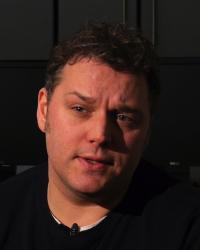
Biography
My work is generally concerned with systems, and is usually automated in some way. I am interested in the relationship we have with systems: how on the one hand they organize and control our behaviors, while on the other revealing aspects of who we are as humans. This is a dichotomy that results in numerous paradoxes found in my work: exhibitionism/voyeurism, subject/object, public/private, observer/observed, etc. I automate my work in order to directly engage with systems rather than simply illustrate or represent them. I want to take advantage of their dynamic qualities, see where their logic takes us, and find out how they author the world around us.
My recent projects highlight my approach to using systems. Common to all of them is a concern with multiplicity: I am fascinated with the idea that an experience can be only one ‘version of events’. Working with systems allows me to present many variations of the same thing, without having to consider that thing in a finite manner. By using autonomous, dynamic real-time systems, each project is in a constant state of becoming, potentially never the same thing twice. As the world changes, the work changes with it, keeping pace via live data streams. I want to question the static, closed nature of an artwork and embrace processes that are much closer to the kinds of experiences we have in our day-to-day lives.
At present I am working on a series of installation projects that explore surveillance. Surveillance Suite has received national funding and support from Creative Capital, and local support from 4Culture and the City of Seattle. The installations use a network of video cameras running computer vision algorithms that “profile” people in an exhibition space based on their age, gender, race, facial expressions and spatial locations. People in the space are cast into a series of short narrative films based upon who they are and what they do. The films are auto-generated in real-time and displayed on monitors. The result is a reconfiguration of the gallery taking account of the narrative and cinematic potential of its spaces and visitors.
Research
Research Advised
- #pandemic 2020
- Remembrance: Magma, Chanee Choi, 2022
- "Manifold" - an interactive immersive game In-progress, Eleanor Jones, 2021
- Natural Language Processing AI project, Eleanor Jones, 2021
- Chanhee Choi, Unreal Window (part1), ISEA 2022 Barcelona, January 2021
- Multi-audio channels installation
- Sangjun, Yoo
- Sangjun, Yoo and Daniel E Roberts
- Silicone Love - Her Finger, Chun Shao, Dec 2017
- Silicone Love - Intro, Chun Shao, May 2017
- The Two Passing Times, Yun Mi Her, 2016
- prosthesis memoria for two performers and EEG by: Daniel Peterson and Adam Hogan, 2016
- Whisper Mirror, Chun Shao, 2015
- #home, Joel Ong, 2015
- a Box, a sound Installation, Haein Kang, 2015
- Container Study, 3D Sound Installation, Daniel Peterson, 2015
- I'll Make Myself A Memory, Martin Jarmick, 2015
- Site Machines, Site Specific Multimedia Installation at Seattle’s Suyama Space - Live video, neon, kinetic sculpture, and sound, Tivon Rice, 2014
- Convex Mirror, public art installation by Robert Twomey, South Lake Union, Seattle, (December 2013 - February 2014)
- Searle's Room, speech and drawing system, Robert Twomey, 2013
- Face Swap, interactive video work by Robert Twomey. Meany Hall for the Performing Arts, Seattle (September 2013 - April 2014)
- Arcade Zero, Multimedia Installation at The Seoul Museum of Art's Nanji Gallery - Real-time audio and video, kinetic sculpture, video projection, neon, Tivon Rice, 2012
- Kinetic immersive sound installation, Eleanor Jones, 2021